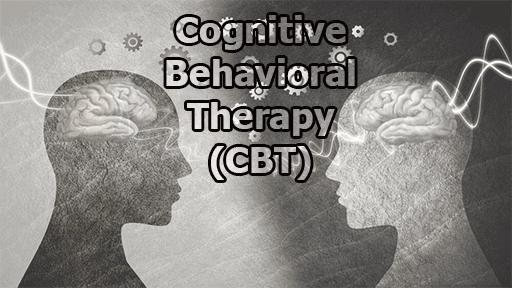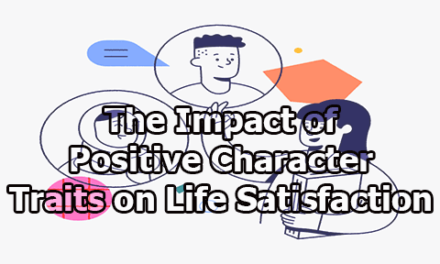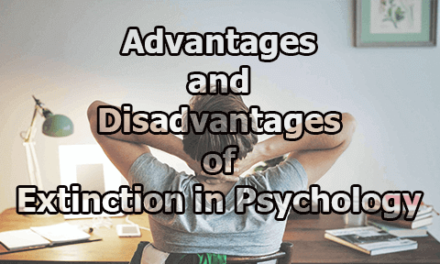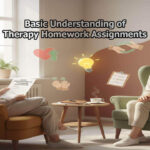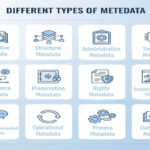Cognitive Behavioral Therapy (CBT):
Cognitive Behavioral Therapy (CBT) is a widely recognized and evidence-based psychotherapeutic approach that focuses on identifying and modifying negative thought patterns and behaviors. Rooted in the principle that our thoughts, feelings, and behaviors are interconnected, CBT aims to help individuals develop healthier thinking patterns to improve emotional regulation and develop personal coping strategies (Dobson & Dozois, 2021). In the rest of this article, we will explore Cognitive Behavioral Therapy (CBT), including its techniques, worksheets, and applications.
What is Cognitive Behavioral Therapy (CBT)?
Cognitive Behavioral Therapy (CBT) is one of the most widely researched and practiced forms of psychotherapy. However, while its core principles are consistent—focusing on the interplay between thoughts, emotions, and behaviors—different thought leaders and clinicians have offered unique perspectives on what CBT entails, how it works, and why it’s effective. Below is a synthesis of CBT through the lenses of various influential psychologists and researchers.
1. Aaron T. Beck’s Perspective (The Foundational Model): Aaron T. Beck, considered the father of CBT, originally developed the approach to treat depression. According to Beck, individuals often experience distress because of automatic negative thoughts and maladaptive cognitive schemas. CBT, in his view, aims to help clients recognize these distortions and restructure them into more balanced, adaptive ways of thinking.
“Cognitive therapy seeks to alleviate psychological distress by correcting faulty conceptions and self-signals” (Beck, 1976, p. 3).
His model introduced the cognitive triad: negative views about the self, the world, and the future, which he believed were central to depression.
Key Features in Beck’s CBT:
- Cognitive distortions (e.g., overgeneralization, catastrophizing)
- Collaborative empiricism
- Socratic questioning
- Thought records and behavioral experiments
2. Albert Ellis’s Perspective (Rational Emotive Behavior Therapy (REBT)): Though technically distinct from CBT, Albert Ellis’s Rational Emotive Behavior Therapy is considered one of its key precursors. Ellis focused on irrational beliefs and emphasized the A-B-C model:
- A: Activating Event
- B: Beliefs
- C: Consequences
Ellis believed that emotional disturbances stemmed not from events themselves, but from rigid and irrational beliefs about those events (e.g., “I must be perfect,” “Others must treat me fairly”).
“People are not disturbed by things, but by the view they take of them” (Ellis, 1962, p. 54).
Key Features in Ellis’s REBT:
- Focus on unconditional self-acceptance
- Disputing irrational beliefs
- Emphasis on philosophy and logic
- Encouraging emotional responsibility
3. Judith S. Beck’s Perspective (A Practical and Structured Approach): Judith Beck, Aaron Beck’s daughter and a leading CBT trainer, emphasizes a structured, goal-oriented, and time-limited approach in her clinical manuals. She focuses on integrating cognitive restructuring with behavioral strategies in a collaborative framework.
“CBT is based on the cognitive model: the way individuals perceive a situation is more closely connected to their reaction than the situation itself” (Beck, 2011, p. 3).
Her work highlights the importance of guided discovery, homework assignments, and tailoring interventions to the client’s belief system.
Key Features in J. Beck’s CBT:
- Structured session plans
- Problem-solving focus
- Homework assignments
- Core belief identification
4. Christine A. Padesky and Kathleen Mooney (Strength-Based CBT): Christine Padesky and Kathleen Mooney advocate for a strength-based version of CBT, which incorporates clients’ existing resources and resilience into therapy. They view CBT not only as a tool to fix problems but as a framework for building personal strengths and psychological flexibility.
“When clients are able to access their strengths, they are more motivated to change and better equipped to manage adversity” (Padesky & Mooney, 2012).
Their work includes the “Four-Square Model” and emphasizes personal agency and long-term coping strategies.
Key Features:
- Strength-based case formulation
- Emphasis on resilience and growth
- Personal model of resilience (PMR)
5. Donald Meichenbaum (Cognitive-Behavioral Modification and Stress Inoculation): Donald Meichenbaum brought a behavioral learning perspective into CBT, blending cognitive restructuring with self-instructional training. His most notable contribution, Stress Inoculation Training (SIT), helps clients prepare for stress by gradually building coping skills through cognitive rehearsal, modeling, and practice.
“Individuals can be trained to become their own cognitive therapists by developing and internalizing self-talk strategies” (Meichenbaum, 1985).
Key Features:
- Self-instructional training
- Phased approach (education, rehearsal, application)
- Emphasis on coping strategies
6. David M. Clark and Adrian Wells (CBT for Anxiety Disorders): These researchers have focused extensively on disorder-specific CBT, especially for anxiety and panic disorders. Clark developed CBT for Social Anxiety, emphasizing cognitive models of self-focused attention and avoidance. Adrian Wells expanded this with his Metacognitive Therapy (MCT), which challenges beliefs about one’s thoughts (e.g., “Worrying helps me cope”).
“It’s not just the content of the thought that matters, but what people believe about their thinking process” (Wells, 2000).
Key Features:
- Attention training
- Metacognitive beliefs
- Behavioral experiments and imagery rescripting
Final Integration (A Multifaceted Therapy): Although their emphases differ—from thoughts, beliefs, and behaviors to strengths, resilience, and metacognitions—these experts collectively contribute to a flexible, empirically supported framework. Modern CBT draws from all these perspectives to create tailored interventions for a wide range of psychological challenges, from depression and anxiety to trauma and personality disorders.
Understanding Cognitive Distortions:
Cognitive distortions are inaccurate or biased ways of thinking that reinforce negative thought patterns and emotions. First introduced by Aaron T. Beck, the father of Cognitive Behavioral Therapy (CBT), these distortions are habitual ways in which our mind convinces us of something that isn’t really true, often reinforcing negative thinking and emotions (Beck, 1979). Identifying and addressing these distortions is a foundational step in CBT, as they significantly contribute to emotional distress and maladaptive behavior.
These faulty thought patterns operate automatically and are often deeply ingrained, meaning individuals may not even be aware they are engaging in them. When unchallenged, cognitive distortions can maintain or even exacerbate mental health issues such as depression, anxiety, and stress-related disorders (Burns, 1980). Here are some of the most common cognitive distortions:
1. All-or-Nothing Thinking (Black-and-White Thinking): This involves viewing situations in extreme, either/or categories with no room for middle ground. For example, a student who receives a B+ on an exam might think, “I’m a total failure,” because they didn’t get an A.
Why it’s harmful: It sets unrealistic standards and can lead to feelings of failure, even when performance is objectively good.
2. Overgeneralization: Drawing broad conclusions from a single event or a small piece of evidence. For instance, if a person is rejected once, they might think, “Nobody will ever love me.”
Why it’s harmful: It creates a fixed negative worldview, promoting hopelessness and avoidance behaviors.
3. Mental Filtering: Focusing only on the negative aspects of a situation and ignoring the positives. For example, after receiving feedback with both praise and critique, someone may only dwell on the criticism.
Why it’s harmful: This distortion can fuel low self-esteem and pessimism, distorting reality into a negative bias (Beck, 1979).
4. Disqualifying the Positive: Rejecting positive experiences or feedback by insisting they “don’t count.” For instance, saying, “They’re just being nice,” when receiving a compliment.
Why it’s harmful: It invalidates genuine positive moments, reinforcing feelings of inadequacy.
5. Jumping to Conclusions: Assuming things without sufficient evidence. This comes in two forms:
- Mind Reading: Believing you know what others are thinking (e.g., “She thinks I’m boring”).
- Fortune Telling: Predicting a negative outcome without proof (e.g., “I’ll definitely mess up this presentation”).
Why it’s harmful: These assumptions can lead to unnecessary anxiety and avoidance of social or performance situations (Burns, 1980).
6. Catastrophizing (Magnification) and Minimization: Exaggerating the importance of problems (catastrophizing) or downplaying the importance of positive traits (minimization). For example, someone may think, “If I make one mistake, my career is over.”
Why it’s harmful: This intensifies fear and prevents people from recognizing their strengths and capabilities.
7. Emotional Reasoning: Believing that something is true simply because it feels that way. For instance, “I feel useless, so I must be useless.”
Why it’s harmful: Emotions are treated as facts, which can lead to distorted self-perceptions and poor decision-making (Leahy et al., 2012).
8. Should Statements: Criticizing oneself or others with rigid “should,” “must,” or “ought” statements. For example, “I should always be in control” or “People must treat me fairly.”
Why it’s harmful: These unrealistic expectations often result in guilt, frustration, and resentment.
9. Labeling and Mislabeling: Assigning labels to oneself or others based on a single event. For example, “I’m a loser” instead of “I made a mistake.”
Why it’s harmful: This oversimplifies complex human behavior and fosters shame and self-criticism.
10. Personalization and Blame: Assuming personal responsibility for events outside one’s control or blaming others excessively. For example, thinking, “It’s my fault my friend is upset,” or “Everything bad in my life is because of other people.”
Why it’s harmful: These distortions can lead to chronic guilt or deflection of responsibility, which hinders personal growth and emotional well-being.
Importance in Therapy: Helping clients identify and correct these distortions is a key goal of CBT. Therapists often use tools like thought records, Socratic questioning, and cognitive restructuring to challenge these faulty beliefs and replace them with more adaptive and realistic ones (Beck, 2011; Leahy et al., 2012).
By recognizing these patterns, individuals gain greater control over their thoughts and emotions, leading to improved mental health and resilience.
Essential CBT Techniques and Tools:
Cognitive Behavioral Therapy (CBT) is a structured, goal-oriented, and evidence-based form of psychotherapy that aims to modify unhelpful thought patterns and behaviors. Central to CBT is the belief that psychological problems are partly based on distorted thinking and learned patterns of unhelpful behavior. Using specific techniques, individuals can unlearn these patterns and build more constructive ways of thinking and behaving (Beck, 2011). Below are nine essential CBT techniques and tools that are commonly used in both individual and group therapy settings.
1. Cognitive Restructuring (Cognitive Reframing): This technique involves identifying, challenging, and replacing irrational or maladaptive thoughts—often known as cognitive distortions—with more realistic and balanced ones. For example, a person thinking “I always mess things up” might learn to replace that thought with “Sometimes I make mistakes, but I also succeed often.”
Application: Therapists use guided questions to examine evidence for and against a belief and help clients generate alternative perspectives (Beck, 2011).
2. Behavioral Activation: Behavioral activation focuses on helping individuals increase engagement in positively reinforcing activities. It is particularly effective for treating depression, where individuals tend to withdraw from social and pleasurable experiences.
Example: Scheduling enjoyable and meaningful activities throughout the week to elevate mood and combat anhedonia (Martell et al., 2010).
3. Thought Records: Thought records are structured worksheets used to document distressing thoughts, identify the accompanying emotions and behaviors, and evaluate their validity. They help clients become more aware of negative thinking patterns and learn to challenge them.
Example: A client records a triggering situation, their automatic thoughts, emotional responses, evidence supporting or disputing the thought, and an alternative rational thought (Greenberger & Padesky, 2016).
4. Exposure Therapy: Often used for anxiety disorders, exposure therapy involves gradual, systematic exposure to feared objects, situations, or thoughts in a controlled environment. The goal is to reduce fear over time through habituation.
Example: A person with social anxiety may be gradually exposed to social situations, starting from making eye contact to initiating small talk (Craske et al., 2014).
5. Activity Scheduling: Activity scheduling is used to increase engagement in rewarding activities. It helps clients structure their days to include tasks that bring a sense of accomplishment or pleasure, thereby improving mood.
Example: A client creates a weekly calendar that includes physical activity, hobbies, or time with friends (Leahy et al., 2012).
6. Problem-Solving Training: This technique helps clients develop a structured approach to tackling life’s challenges. It involves identifying the problem, brainstorming solutions, evaluating the pros and cons of each, and implementing a plan.
Benefit: Clients gain confidence in their ability to cope with problems and reduce feelings of helplessness (Nezu et al., 2013).
7. Relaxation Techniques: CBT integrates physical strategies such as deep breathing, progressive muscle relaxation, and guided imagery to manage physiological symptoms of anxiety and stress.
Example: Progressive muscle relaxation involves tensing and relaxing each muscle group to reduce physical tension and promote calmness (Bernstein et al., 2000).
8. Socratic Questioning: Socratic questioning is a dialogical technique where the therapist asks a series of guided questions to help the client explore their beliefs and challenge irrational thinking. It promotes insight and critical thinking.
Example: Questions like “What’s the evidence for that belief?” or “What would you say to a friend who thought that?” help dismantle cognitive distortions (Beck, 2011).
9. Graded Exposure and Hierarchy Development: This technique is especially useful for phobias and avoidance behaviors. The client and therapist collaboratively create a hierarchy of feared situations and then work through them from least to most anxiety-inducing.
Example: Someone with a fear of flying might start with looking at pictures of airplanes, then visiting an airport, and eventually taking a short flight (Foa & Kozak, 1986).
These CBT techniques provide practical tools for clients to manage a wide range of psychological issues, including depression, anxiety disorders, PTSD, OCD, and more. Each technique fosters self-awareness, emotional regulation, and behavior change—empowering individuals to take an active role in their healing process.
CBT Worksheets and Exercises:
CBT is a highly structured and goal-oriented form of therapy that emphasizes skill-building. To translate abstract cognitive and behavioral concepts into actionable steps, therapists often use worksheets and structured exercises. These tools help individuals identify, evaluate, and challenge problematic thoughts and behaviors, while also reinforcing learning and providing a tangible framework for progress between sessions (Beck, 2011; Greenberger & Padesky, 2016).
CBT worksheets aren’t just about filling in boxes—they promote reflection, self-awareness, and problem-solving, and can be customized based on individual therapy goals. Below are several commonly used worksheets and exercises in CBT, each designed to target specific aspects of cognition and behavior.
1. Dysfunctional Thought Record (DTR): The Dysfunctional Thought Record is a classic CBT worksheet used to track and examine automatic thoughts that cause distress. Clients record the situation, their emotional and behavioral response, the automatic thought, and then evaluate the evidence for and against that thought.
Example:
- Situation: Gave a presentation at work.
- Automatic Thought: “I sounded stupid.”
- Emotion: Embarrassment, anxiety.
- Evidence For: I stumbled on one sentence.
- Evidence Against: No one seemed bothered; a colleague complimented me afterward.
- Alternative Thought: “I made a few small mistakes, but overall I did fine.”
Why it works: Helps clients develop cognitive flexibility and challenge negative automatic thoughts (Greenberger & Padesky, 2016).
2. ABC Functional Analysis Worksheet: This tool uses the ABC model (Antecedent, Behavior, Consequence) to help clients understand the chain of events surrounding a behavior or emotional response.
Example:
- Antecedent: Received critical feedback from a supervisor.
- Behavior: Became defensive and avoided work the next day.
- Consequence: Increased stress and guilt.
Purpose: Identifies patterns and potential intervention points for behavior change (Ellis, 1962).
3. Cognitive Distortion Identification Worksheet: Clients use this worksheet to identify and label specific cognitive distortions in their thinking (e.g., all-or-nothing thinking, catastrophizing, mind reading).
Example:
- Thought: “If I don’t get everything perfect, I’ll fail.”
- Distortion: All-or-nothing thinking.
Why it works: Promotes awareness of how specific thought patterns contribute to emotional distress (Beck, 2011; Burns, 1980).
4. Thought-Challenging Worksheet: A deeper version of cognitive restructuring, this worksheet helps clients dissect their thoughts step-by-step:
- What’s the situation?
- What thought went through your mind?
- What’s the evidence for and against the thought?
- What’s an alternative thought?
- How much do you believe this new thought?
Goal: Encourage more balanced thinking and reduce the intensity of emotional reactions (Leahy et al., 2012).
5. Graded Exposure Hierarchy: This exercise helps clients gradually confront feared situations in a structured way. They rank situations from least to most anxiety-provoking and work through them step by step.
Example: A client with a fear of public speaking might build a hierarchy:
- Rank 1: Practicing alone.
- Rank 2: Speaking in front of a friend.
- Rank 3: Joining a small group conversation.
- Rank 4: Presenting to a team at work.
Why it works: Reduces avoidance behaviors and desensitizes fear responses through controlled exposure (Craske et al., 2014).
6. Behavioral Experiment Worksheet: Clients are encouraged to test their fears or negative beliefs in real life through planned behavioral experiments.
Example: A person who believes “If I speak up, people will judge me” might test this belief by contributing an opinion in a group setting and recording what actually happens.
Purpose: Challenges irrational beliefs through real-world data rather than speculation (Bennett-Levy et al., 2004).
7. Activity Scheduling Worksheet: This worksheet helps clients plan and commit to engaging in enjoyable or meaningful activities, especially helpful for those experiencing depression or anhedonia.
Structure: Includes time slots, specific activities, and mood ratings before and after the activity.
Example: Monday at 6 PM – Go for a walk in the park.
- Before mood: 4/10
- After mood: 7/10
Benefit: Reinforces positive behavior and reduces passivity (Martell et al., 2010).
8. Case Formulation Worksheet (4Ps Model): This worksheet allows for a holistic look at a client’s problem using the 4Ps framework:
- Predisposing (e.g., childhood trauma),
- Precipitating (e.g., recent job loss),
- Perpetuating (e.g., isolation),
- Protective (e.g., supportive partner).
Use: Helps guide treatment planning and prioritize intervention areas (Kuyken et al., 2009).
9. Core Beliefs Worksheet: This exercise helps clients identify and challenge deeply held negative core beliefs (e.g., “I’m unlovable,” “I’m a failure”) and replace them with healthier beliefs.
Steps:
- Identify negative core beliefs.
- Gather evidence for and against them.
- Explore origins.
- Replace with adaptive core beliefs.
- Monitor reinforcement over time.
Why it works: Addressing core beliefs leads to long-lasting cognitive and emotional change (Beck, 2011).
CBT worksheets and exercises are essential components of therapeutic practice. They empower clients to actively engage in their healing process by externalizing internal struggles and providing a structured method for cognitive and behavioral change. Used consistently, these tools support therapy goals, promote self-efficacy, and accelerate progress outside the therapy room.
Positive CBT (A Strength-Based Approach):
Traditional Cognitive Behavioral Therapy (CBT) has long focused on identifying and correcting dysfunctional thoughts, beliefs, and behaviors. However, a growing evolution in therapeutic practice has given rise to Positive CBT—a complementary, strength-based approach that shifts the focus from deficits to client strengths, values, and positive experiences (Bannink, 2012).
Rather than merely addressing what’s wrong, Positive CBT asks: What’s going right, and how can we build on that? It aims to foster resilience, optimism, and well-being, offering a more holistic and empowering therapeutic experience.
Core Principles of Positive CBT: Positive CBT doesn’t discard traditional CBT principles; instead, it integrates them with the insights from positive psychology, which emphasizes human flourishing and optimal functioning (Seligman & Csikszentmihalyi, 2000). Here are its foundational principles:
- Focus on Strengths – Identify what the client does well and how those strengths can be applied to overcome challenges.
- Future-Oriented Thinking – Emphasize hopes, goals, and desired outcomes rather than past traumas or dysfunctions.
- Empowerment Over Pathology – Clients are viewed as resourceful and capable, not as broken or deficient.
- Use of Positive Emotions – Encourage and harness emotions like gratitude, hope, love, and curiosity to improve resilience and cognitive flexibility.
- Solution-Building Rather Than Problem-Solving – Instead of dwelling on problems, focus on building solutions using what already works (Bannink, 2012).
Techniques and Tools in Positive CBT: Below are several techniques used in Positive CBT that support a strengths-based framework:
1. Best Possible Self Exercise: Clients imagine their life in the future, having achieved all their goals and overcome obstacles. They then write or speak about this vision in detail.
Purpose: Boosts optimism, motivation, and commitment to goals (King, 2001).
2. Strength Spotting: Therapists help clients identify their signature strengths—such as perseverance, humor, kindness, or creativity—using tools like the VIA Character Strengths Survey.
Application: Encourage clients to use these strengths in challenging situations (Niemiec, 2013).
3. Gratitude Journaling: Clients are asked to keep a journal of three things they’re grateful for each day. This simple but powerful exercise shifts attention away from problems and toward positive life experiences.
Research: Regular practice increases life satisfaction and decreases depressive symptoms (Emmons & McCullough, 2003).
4. Miracle Question (from Solution-Focused Brief Therapy): “If a miracle happened overnight and your problem was solved, what would be the first signs?” This technique shifts focus from the problem to the desired outcome, fostering hope and clarity.
Why it works: Encourages goal-directed thinking and emotional engagement (De Shazer et al., 2021).
5. Complimenting and Positive Feedback: Therapists offer sincere, specific praise for clients’ efforts and progress. This builds a sense of competence and self-efficacy.
Example: “You handled that situation with patience and clarity—that shows real emotional growth.”
6. Highlighting Exceptions: Focuses on times when the problem didn’t occur or was less severe. The goal is to explore what was different about those situations and how to replicate them.
Example: If a client says they’ve been anxious all week except for Wednesday, the therapist might ask, “What was different about Wednesday?”
7. Values Clarification: Clients explore what truly matters to them—such as family, learning, or authenticity—and then align their goals and behaviors with these values.
Outcome: Leads to increased motivation and long-term goal commitment (Hayes et al., 1999).
Benefits of Positive CBT:
- Boosts Well-being: By building on positive emotion, engagement, and meaning, clients often experience greater life satisfaction.
- Improves Treatment Engagement: A strengths-based, encouraging approach can be less intimidating and more appealing to clients.
- Reduces Relapse: Encouraging self-awareness of strengths and successes promotes long-term resilience.
- Supports Flourishing: Moves clients beyond symptom reduction toward personal growth and thriving.
Case Example: A young adult client experiencing anxiety is asked to reflect on times they successfully managed their stress. Through strength spotting, they identify that their planning and organizational skills help reduce overwhelm. They begin applying this strength deliberately when approaching exams, which leads to both reduced anxiety and increased academic performance.
Integrating Positive CBT with Traditional CBT: Therapists can blend Positive CBT with traditional models by:
- Using thought records to challenge distortions and affirm client strengths.
- Incorporating gratitude or optimism exercises into behavioral activation plans.
- Reframing cognitive distortions with values-based, forward-thinking alternatives.
This integration helps clients address their challenges while also nurturing positive aspects of themselves and their lives.
Positive CBT transforms the therapeutic lens from deficit to possibility. By helping clients discover, celebrate, and expand their strengths, therapists can foster not just recovery, but flourishing. It’s not about ignoring problems—it’s about solving them through the lens of resilience, hope, and potential.
In conclusion, Cognitive Behavioral Therapy (CBT) offers a versatile and effective framework for addressing a wide range of psychological issues. By combining evidence-based techniques with practical exercises, CBT empowers individuals to take an active role in their mental health journey. Whether through traditional methods or the strength-based approach of Positive CBT, this therapeutic model continues to provide valuable tools for personal growth and emotional well-being.
Frequently Asked Questions (FAQs):
What is CBT and how does it work?
CBT (Cognitive Behavioral Therapy) is a structured, time-limited psychotherapy that helps individuals identify and change unhelpful patterns of thinking, behavior, and emotions. It works by helping clients challenge distorted thoughts (cognitive distortions), adopt more realistic thinking, and engage in behaviors that support emotional well-being.
What types of issues can CBT help with?
CBT is effective for a wide range of mental health conditions, including:
- Depression
- Anxiety disorders (e.g., GAD, social anxiety, panic disorder)
- PTSD and trauma-related issues
- Eating disorders
- Substance abuse
- Insomnia
- OCD
- Chronic pain and stress
How long does CBT typically last?
CBT is usually short-term. A typical treatment course ranges from 5 to 20 sessions, depending on the individual’s goals, severity of symptoms, and the specific issue being addressed. Some versions, like CBT for PTSD, can be more intensive or structured differently.
What happens in a CBT session?
CBT sessions are collaborative and structured. You and your therapist:
- Set goals
- Review progress
- Identify problematic thoughts and behaviors
- Use worksheets, thought records, or role-play
- Assign homework to apply skills in real life
Is CBT evidence-based?
Yes. CBT is one of the most extensively researched forms of psychotherapy. Meta-analyses and randomized controlled trials have consistently shown its effectiveness in treating a variety of disorders, especially anxiety and depression.
What are cognitive distortions?
Cognitive distortions are habitual ways of thinking that are inaccurate and negatively biased. Common examples include:
- Catastrophizing
- All-or-nothing thinking
- Overgeneralization
- Personalization
CBT teaches individuals to recognize and reframe these patterns.
Can CBT be done online or through self-help?
Absolutely. CBT is highly adaptable and can be delivered:
- In person
- Online (via video or apps)
- Through guided or unguided self-help books and worksheets
Studies show internet-based CBT (iCBT) can be just as effective for some conditions, especially when supported by a therapist.
What is the difference between CBT and other therapies?
CBT differs from:
- Psychoanalysis: Focuses less on past unconscious conflicts and more on current thinking and behavior.
- Humanistic therapy: More structured and problem-solving in nature.
- Mindfulness therapies: While CBT can integrate mindfulness, it focuses more on changing thoughts rather than merely observing them.
What are the core techniques used in CBT?
Key techniques include:
- Cognitive restructuring
- Behavioral activation
- Exposure therapy (for anxiety/phobias)
- Problem-solving skills
- Thought records and worksheets
- Goal setting
- Relaxation and coping strategies
Is CBT suitable for children and teens?
Yes. CBT has been adapted effectively for children and adolescents. It can help with behavioral problems, school anxiety, ADHD, depression, and more. Child CBT often includes age-appropriate activities and may involve parents in the therapy process.
Can CBT be used alongside medication?
Yes. CBT is often used in combination with medications like antidepressants. Many studies show that combining CBT with medication can lead to better outcomes, particularly for moderate to severe depression and anxiety.
Do I need to be in crisis to benefit from CBT?
Not at all. CBT is not just for people in crisis. It can be helpful for anyone seeking to improve their thinking patterns, manage stress, develop coping skills, or reach personal goals—even if they don’t have a diagnosed mental health condition.
Are there any limitations to CBT?
While CBT is highly effective, it may not be the best fit for everyone. Limitations include:
- It requires active participation and practice outside sessions.
- It may not delve deeply into early life experiences unless integrated with other approaches.
- Some individuals may prefer more insight-oriented or emotionally expressive therapies.
How do I find a CBT therapist?
You can search for a licensed CBT therapist through:
- com
- National health services (e.g., NHS in the UK)
- Therapy directories (e.g., APA, BABCP)
- Look for providers with CBT training and credentials from recognized institutions.
What makes CBT so popular?
CBT’s popularity stems from its:
- Strong scientific backing
- Structured, time-efficient model
- Practical, skills-based approach
- Clear goals and measurable outcomes
- Adaptability to a wide range of issues and populations
References:
- Abramowitz, J. S. (1996). Variants of exposure and response prevention in the treatment of obsessive-compulsive disorder: A meta-analysis. Behavior Therapy, 27(4), 583–600. https://doi.org/10.1016/S0005-7894(96)80045-1
- Andersson, G., Cuijpers, P., Carlbring, P., Riper, H., & Hedman, E. (2014). Guided Internet-based vs. face-to-face cognitive behavior therapy for psychiatric and somatic disorders: A systematic review and meta-analysis. World Psychiatry, 13(3), 288–295. https://doi.org/10.1002/wps.20151
- Arntz, A. (2002). Cognitive therapy versus interoceptive exposure as treatment of panic disorder without agoraphobia. Behaviour Research and Therapy, 40(3), 325–341. https://doi.org/10.1016/s0005-7967(01)00014-6
- Bannink, F. P. (2012). Practicing positive CBT: From reducing distress to building success. Wiley-Blackwell.
- Beck, A. T. (1979). Cognitive therapy and the emotional disorders. Penguin.
- Beck, J. S. (2011). Cognitive behavior therapy: Basics and beyond (2nd ed.). Guilford Press.
- Bernstein, D. A., Borkovec, T. D., & Hazlett-Stevens, H. (2000). New directions in progressive relaxation training: A guidebook for helping professionals. Praeger Publishers/Greenwood Publishing Group.
- Boyes, A. (2015). The Anxiety Toolkit. Hachette Australia.
- Bennett-Levy, J., Butler, G., Fennell, M., Hackman, A., Mueller, M., & Westbrook, D. (Eds.). (2004). Oxford guide to behavioural experiments in cognitive therapy. Oxford University Press. https://doi.org/10.1093/med:psych/9780198529163.001.0001
- Burns, D. D. (1980). Feeling good: The new mood therapy. William Morrow and Company.
- Butler, A. C., Chapman, J. E., Forman, E. M., & Beck, A. T. (2006). The empirical status of cognitive-behavioral therapy: A review of meta-analyses. Clinical Psychology Review, 26(1), 17–31. https://doi.org/10.1016/j.cpr.2005.07.003
- Clark, D. M. (2001). A cognitive perspective on social phobia. In W. R. Crozier & L. E. Alden (Eds.), International handbook of social anxiety: Concepts, research and interventions relating to the self and shyness (pp. 405–430). John Wiley & Sons Ltd.
- Craske, M. G., Treanor, M., Conway, C. C., Zbozinek, T., & Vervliet, B. (2014). Maximizing exposure therapy: An inhibitory learning approach. Behaviour Research and Therapy, 58, 10–23. https://doi.org/10.1016/j.brat.2014.04.006
- Cuijpers, P., Karyotaki, E., Weitz, E., Andersson, G., Hollon, S. D., & van Straten, A. (2014). The effects of psychotherapies for major depression in adults on remission, recovery and improvement: A meta-analysis. Journal of Affective Disorders, 159, 118–126. https://doi.org/10.1016/j.jad.2014.02.026
- De Shazer, S., Dolan, Y., Korman, H., Trepper, T., McCollum, E. and Berg, I.K. (2021) More than Miracles the State of the Art of Solution-Focused Brief Therapy. Routledge, New York. https://doi.org/10.4324/9781003125600
- Dobson, K. S., & Dozois, D. J. (2021). Handbook of cognitive-behavioral therapies. The Guilford Press.
- Ellis, A. (1962). Reason and emotion in psychotherapy. Lyle Stuart.
- Emmons, R. A., & McCullough, M. E. (2003). Counting blessings versus burdens: An experimental investigation of gratitude and subjective well-being in daily life. Journal of Personality and Social Psychology, 84(2), 377–389. https://doi.org/10.1037/0022-3514.84.2.377
- Foa, E. B., & Kozak, M. J. (1986). Emotional processing of fear: Exposure to corrective information. Psychological Bulletin, 99(1), 20–35. https://doi.org/10.1037/0033-2909.99.1.20
- Geschwind, N., Arntz, A., Bannink, F., & Peeters, F. (2019). Positive cognitive behavior therapy in the treatment of depression: A randomized order within-subject comparison with traditional cognitive behavior therapy. Behaviour Research and Therapy, 116, 119–130. https://doi.org/10.1016/j.brat.2019.03.005
- Greenberger, D., & Padesky, C. A. (2016). Mind over mood: Change how you feel by changing the way you think (2nd ed.). Guilford Press.
- Hayes, S. C., Strosahl, K. D., & Wilson, K. G. (1999). Acceptance and commitment therapy: An experiential approach to behavior change. Guilford Press.
- Hofmann, S. G., Asnaani, A., Vonk, I. J., Sawyer, A. T., & Fang, A. (2012). The Efficacy of Cognitive Behavioral Therapy: A Review of Meta-analyses. Cognitive Therapy and Research, 36(5), 427–440. https://doi.org/10.1007/s10608-012-9476-1
- King, L. A. (2001). The health benefits of writing about life goals. Personality and Social Psychology Bulletin, 27(7), 798–807. https://doi.org/10.1177/0146167201277003
- Kuyken, W., Padesky, C. A., & Dudley, R. (2009). Collaborative case conceptualization: Working effectively with clients in cognitive-behavioral therapy. The Guilford Press.
- Leahy, R. L., Holland, S. J. F., & McGinn, L. K. (2012). Treatment plans and interventions for depression and anxiety disorders (2nd ed.). Guilford Press.
- Martell, C. R., Dimidjian, S., & Herman-Dunn, R. (2010). Behavioral activation for depression: A clinician’s guide. Guilford Press.
- Meichenbaum, D. (1985). Stress inoculation training. New York: Pergamon Press.
- Nezu, A. M., Nezu, C. M., & D’Zurilla, T. J. (2013). Problem-solving therapy: A positive approach to clinical intervention (3rd ed.). Springer Publishing.
- Niemiec, R. M. (2013). VIA Character Strengths: Research and Practice (The First 10 Years). In H. H. Knoop, & A. Delle Fave (éds.), Well-Being and Cultures (Vol. 3, pp. 11-29). Dordrecht: Springer Netherlands. https://doi.org/10.1007/978-94-007-4611-4_2
- Padesky, C. A., & Mooney, K. A. (2012). Strengths-based cognitive-behavioural therapy: A four-step model to build resilience. Clinical Psychology & Psychotherapy, 19(4), 283–290. https://doi.org/10.1002/cpp.1795
- Puri, P., Kumar, D., Muralidharan, K., & Kishore, M. T. (2021). Evaluating schema modes and cognitive distortions in borderline personality disorder: A mixed‐method approach. Journal of Clinical Psychology, 77(9), 1973–1984. https://doi.org/10.1002/jclp.23126
- Seligman, M. E. P., & Csikszentmihalyi, M. (2000). Positive psychology: An introduction. American Psychologist, 55(1), 5–14. https://doi.org/10.1037/0003-066X.55.1.5
- Wells, A. (2000). Emotional disorders and metacognition: Innovative cognitive therapy. John Wiley & Sons Ltd.

Library Lecturer at Nurul Amin Degree College

